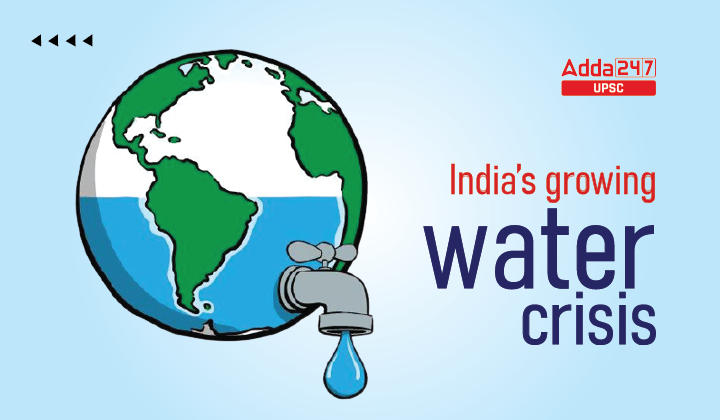Table of Contents
India’s growing water crisis- Relevance for UPSC Exam
General Studies III- Conservation, Environmental Pollution & Degradation, EIA.
In News
- United Nations World Water Development Report of 2022 has expressed global concern over the sharp rise in freshwater withdrawal from streams, lakes, aquifers and human made reservoirs, significant water stress and also water scarcity being experienced in different parts of the world.
Who publishes the UNs world water development report?
- The United Nations World Water Development Report (WWDR) is published by UNESCO, on behalf of UN-Water and its production is coordinated by the UNESCO World Water Assessment Program (WWAP).
What is the level of water stress in India?
- The Global Drought Risk and Water Stress map (2019): It shows that major parts of India, particularly west, central and parts of peninsular India are highly water stressed and experience water scarcity.
- Composite Water Management Index (2018): Released by Niti Aayog indicates that more than 600 million people are facing acute water stress.
- India is the world’s largest extractor of groundwater: Accounting for 25 per cent of the total. 70 percent of our water sources are contaminated and our major rivers are dying because of pollution.
Why is Rural to Urban transfer of water becoming an issue in India?
- Rising urban population: According to Census 2011, the urban population in India accounted for 34% of total population. It is estimated that the urban population component in India will cross the 40% mark by 2030 and the 50% mark by 2050 according to World Urbanization Prospects, 2018.
- Water use in the urban areas: Water use in the urban sector has increased as more and more people shift to urban areas. Per capita use of water in these centers rises, which will continue to grow with improved standards of living.
- Shifting of water source in Urban areas: As the city grows and water management infrastructures develop, dependence shifts to surface water from groundwater. For example: In Ahmedabad, more than 80% of water supply used to be met from groundwater sources till the mid-1980s. Due to such overexploitation of groundwater the depth to groundwater level reached 67 meters in confined aquifers. The city now depends on the Narmada canal for the bulk of its water supply.
- Dependence of urban areas on rural areas for water source and rural-urban disputes over water: Cities largely depend on rural areas for raw water supply, which has the potential to ignite the rural-urban dispute. For example: Nagpur and Chennai face the problem of rural-urban water disputes.
Reasons for disputes
- Diversion of resource: Water is transported to urban areas at the expense of rural areas. Due to the high population in urban areas the water requirement for daily use is very high.
- High demand of water for industrial purposes: In urban areas the water is heavily used in industries creating water stress.
- High Agriculture dependence: In the rural areas water is used mainly for irrigation purposes and due to heavy dependence on agriculture the water is very essential in rural areas.
- Water pollution: In cities, most of this water is in the form of grey water with little recovery or reuse, eventually contributing to water pollution.
- Bad governance: Politicization of water for vote bank and skewed distribution of water particular regions For example: Andhra and Telangana.
Climate change exacerbate the rural-urban disputes
- Affecting rainfall pattern: Climate change affects the amount of rainfall in the region which is the prime source of both surface water and groundwater.
- Increase rate of evaporation over surface water: because of high temperature the surface waters of lakes, rivers, canals etc. face high evaporation water loss.
- Melting of glaciers: glaciers are the sources for perennial rivers of India. Due to global warming, glaciers are melting and hence affecting the perennial nature of rivers.
- Frequent droughts: It affects the groundwater recharge process and drying of surface waters which creates shortage of water. It exacerbate the rural-urban conflict.
Way forward
- A system perspective and catchment scale based approach are necessary to link reallocation of water with wider discussions on development, infrastructure investment, fostering an rural-urban partnership and adopting an integrated approach in water management.
- The government cannot manage the water crisis alone. It will take the combined efforts of civil society, the private sector including the public at large to meet the challenge.
Conclusion
- Rural and urban areas use water from the same stock, i.e., the water resources of the country. Therefore, it is important to strive for a win- win situation by securing the interests of both urban and rural areas. Good Governance is the key to achieve such a win-win situation.




 TSPSC Group 1 Question Paper 2024, Downl...
TSPSC Group 1 Question Paper 2024, Downl...
 TSPSC Group 1 Answer key 2024 Out, Downl...
TSPSC Group 1 Answer key 2024 Out, Downl...
 UPSC Prelims 2024 Question Paper, Downlo...
UPSC Prelims 2024 Question Paper, Downlo...




